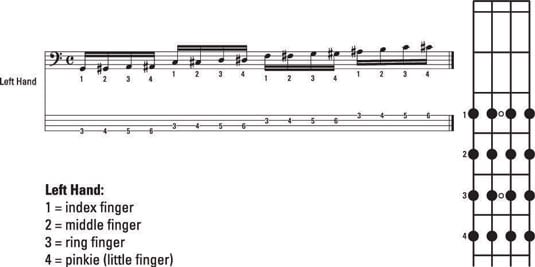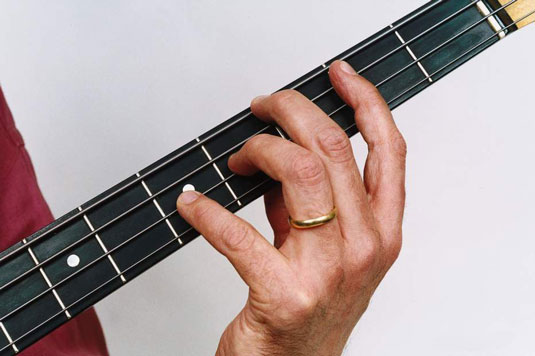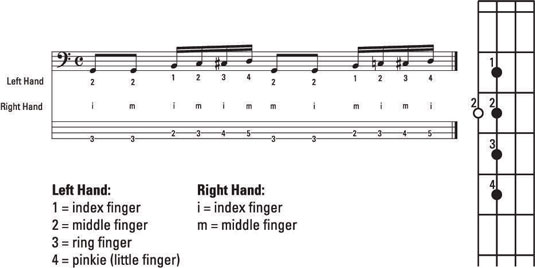The job of your left hand is to press down on the string at the appropriate fret on the bass guitar, which gives you the desired pitch, while the right hand strikes the same string simultaneously, producing the sound. Get ready for one of the best exercises you'll find for bassists. The finger permutation exercise gives you a workout for every possible combination of finger sequences on your left hand.
Here's how it works:
Position your left hand on the neck of the bass so your index finger (1) is on low G (the 3rd fret on the E string).
Spread your fingers so each one covers one fret.
Try to keep your left hand as relaxed as possible as you're covering the frets. This way your hand doesn't tire, and you can move it more quickly.
Press the notes under your fingers, one finger and fret at a time, in this order: 1 2 3 4.
Your right hand strikes the string to sound each note, and you can make little mini-shifts with your left hand to reach all the frets in a relaxed state.
Repeat the process on the A string (the next string), the D string, and then on the G string.
When you complete this finger combination on every string, go back to the E string and do the next combination.
Check out the complete list of left-hand permutations (all the fingerings starting with 1, and then 2, 3, and 4). Practice one column at a time, and repeat the process until you do all the combinations. These exercises give your left hand the desired coordination and strength in only a few short minutes to play all those hip bass lines.
| Starting with the Index Finger | Starting with the Middle Finger | Starting with the Ring Finger | Starting with the Pinkie |
|---|---|---|---|
| 1 2 3 4 | 2 1 3 4 | 3 1 2 4 | 4 1 2 3 |
| 1 2 4 3 | 2 1 4 3 | 3 1 4 2 | 4 1 3 2 |
| 1 3 2 4 | 2 3 1 4 | 3 2 1 4 | 4 2 1 3 |
| 1 3 4 2 | 2 3 4 1 | 3 2 4 1 | 4 2 3 1 |
| 1 4 2 3 | 2 4 1 3 | 3 4 1 2 | 4 3 1 2 |
| 1 4 3 2 | 2 4 3 1 | 3 4 2 1 | 4 3 2 1 |
You can try these exercises on any area of the neck of the bass. On the audio tracks, the exercises start on low G (with the index finger on the 3rd fret of the E string), but don't limit yourself to that area.

Listen to Chapter 3, Audio Track 6 to hear what the left-hand permutations sound like.
Mute the strings to avoid the infamous hum
When you play, you may find that some strings vibrate even though you didn't strike them. Sympathetic vibration (the official name for this hum) is a natural phenomenon. You can silence, or mute, any string by touching it lightly with either your left hand or your right hand, or even with both hands. As you refine your muting technique, sympathetic vibration will become less and less of a problem.
For example, if you strike a low G on the E string, the open G string vibrates as well. Just keep your left-hand fingers in (light) touch with the strings, and you won't hear any vibration. Notice how the undersides of the fingers touch the other strings, preventing them from vibrating.

Put it all together
Try the simple exercise that coordinates the fingering of the left hand with the striking of the right.

Make sure your right hand alternates properly. You start this exercise with a different finger on each repetition (alternating the i and m fingers). As for your left hand, it doesn't have to shift for the entire exercise as long as you use all four left-hand fingers properly.
You can hear this very cool exercise in Chapter 3, Audio Track 7. This exercise doubles as a hip groove. Who says exercises have to be boring?

